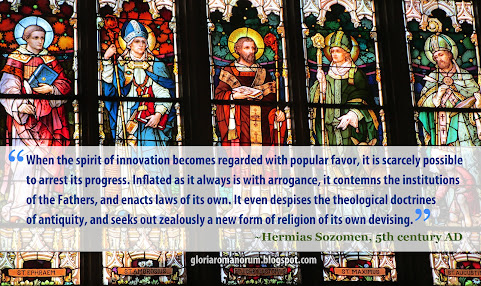 |
| Engraving of Pope Saint Damasus I by Nicolas San Giorgio, AD 1877. |
When reading the Ecclesiastical History of Hermias Sozomen—a work written immediately before the Council of Chalcedon when the universal Church was roiled by a variety of heresies—one picks up the venerable author’s animus for innovation. Indeed, Book IV, Chapter 27 begins with the following passage:
When the spirit of innovation becomes regarded with popular favor, it is scarcely possible to arrest its progress. Inflated as it always is with arrogance, it contemns the institutions of the Fathers, and enacts laws of its own. It even despises the theological doctrines of antiquity, and seeks out zealously a new form of religion of its own devising.
The context of this quote is the turmoil which nearly overwhelmed the Church during the reign of the Arian emperor Constantius II, who gave a free hand to those bishops who had embraced the novelties of Arius to oppress those who supported the decisions of the Council of Nicaea of AD 325.
A quick text search of the rest of Sozomen’s history reveals similar admonitions against novelty and innovation, including a letter from the Church Council convened at Ariminum (Rimini) in Italy in AD 359, during which the bishops of the West petitioned Constantius uphold the Nicene creed and not to allow novel doctrines:
We therefore entreat your Clemency to listen to our deputies and to regard them favorably and not to allow the dead to be dishonored by the introduction of alterations and novelties. We pray you to preserve the tradition which we received from our ancestors, who were all wise and prudent and who, we have reason to believe, were led by the Spirit of God. For these innovations not only lead believers to infidelity, but also delude unbelievers…. Again, we beseech you that nothing be taken away from or added to the faith. Let it remain unchanged even as it has continued from the reign of your father to the present time, so that we may not in the future be compelled to leave our churches and undertake long journeys, but that the bishop and people may dwell together in peace… [Book IV, Chapter XVIII]
Click for more info.
Constantius would not heed this request, however, and would attempt to force the bishops to reject the Nicene formulary of the Faith, even deposing a pope in the process.
Later, Sozomen quotes a letter from Pope St. Damasus to the bishops of Illyria (see the image at the beginning of this post) which says much the same thing:
Those who devise strange doctrines ought not to be followed, but the opinions of our fathers ought to be retained, whatever may be the diversity of opinion around us. [Book VI, Chapter XXIV]
Interestingly, appeal to tradition was such a powerful rhetorical weapon in the ancient Church that prelates who would later be condemned as heretics attempted to wield it. In an account of the Council of Antioch of AD 342, Sozomen recounts how the assembled bishops—including the Arian Eusebius of Nicomedia who was now Bishop of Constantinople—after deposing Saint Athanasius, went on to affirm that “they received the faith which had, from the beginning, been handed down by tradition.” [Book III, Chapter 5]
Given the above, it may be pointed out that this spirit of suppressing novelty and holding fast to tradition has been effectively turned on its head by our bishops over the past century. Sadly, those men who are called specifically to preserve the venerable teachings of the Church oftentimes seem almost manic in their rush to discard them. In place of the holy and eternal doctrines that the Church has always taught, they propose doctrinal and pastoral innovations that look, sound and feel eerily similar to the ephemeral doctrines and practices of the princes of this world.
It is also worth contemplating whether this voluptuous embrace of novelty has caused the Church founded by Jesus Christ to be built up over the past several decades, or to collapse into heap of rubble. In the West, at least, the answer is set starkly before our eyes.
 |
| Ruins of St. Bonaventure Catholic Church, Philadelphia, PA. Built in 1906, demolished in 2013 after lying abandoned for 20 years. Photo from Hidden City. |



No comments:
Post a Comment